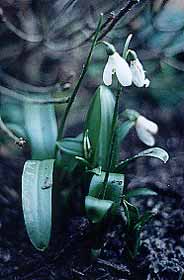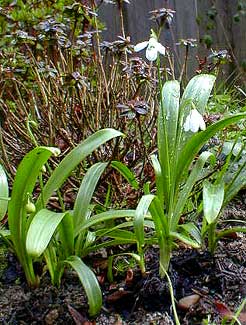
Snowdrops
aka Fair-Maids-in-February
"Tender snowdrops, wee & white,
Go to her whose beauty lies
On my being, like the light
Of the stars on brows of skies."
-George Heath
(1844-1869)
(1844-1869)
Snowdrops, or Garden Snowdrop, originates in cool mountainous regions of eastern Turkey, the Caucasus, northern Iraq & western Iran. In our garden they show their leaves & the occasional random flowerbud at the end of January, but wait until mid-February to put on a notable show.
By the time the first snowdrops are flowering, the majority of our many varieties of snow crocuses will already be in full bloom. In cooler climates than ours, the crocuses will be delayed to the end of February or in March, but cold-loving snowdrops will still bloom by mid-February.
The photo above was shot in mid-February (2003). The second photo is from mid-March, when they're not near through blooming.
 It helps to let their leaves die back naturally in late spring, rather than cut them back after they're finished blooming. To clip them back too soon when the leaves have only begun to yellow deprives the bulbs of the fullest chance to store energy & produce offsets.
It helps to let their leaves die back naturally in late spring, rather than cut them back after they're finished blooming. To clip them back too soon when the leaves have only begun to yellow deprives the bulbs of the fullest chance to store energy & produce offsets.The scientific name Galanthus nivalis means "Snowy Milkblossom," as each bloom looks like droplets of milk. They grow to around six inches of height with nodding white bell flowers. They like moist humousy soil in partial shade. In colder zones they can take full sun. They are very cold-hardy, but do poorly in heat.
They will naturalize with greater certainty in cooler climates, but surprisingly enough temperate Puget Sound is a little warm for them, & they sometimes turn out to be shortlived. Further south they reportedly exhaust themselves attempting to bloom through the entirety of winter, never stopping long enough to recharge their bulbs.
I've planted them around the front of an Oceanlake dwarf rhododendron. Mixed into the same drift are the taller but very similar Leucojum vernum, & in autumn 2003 added bulbs for Double Snowdrops.
The name Snowdrop describes 19 species & innumerable subspecies & variants, of which only two (designated Giant & Lesser) are especially common in gardens, both of these having several cultivars. Most of the species look pretty much alike, all having nodding white flowers. The variations in appearance would not induce many gardeners to collect more than two to six different kinds. But gardeners with a love for extreme subtleties collect as many as they can lay hands on, & speak of their snowdrops with as much sentimentality as parents speak of their infants. Snowdrop fanatics are an admirable & special breed.
The name snowdrops originally alluded to a popular earring style of the 16th & 17th Centuries in Europe, particularly in Germany, but the name stuck because one can so easily imagine any white flower as being a snowdrop. The alternate name Fair-Maids-in-February is older than Snowdrops, as is the now rarely used name Candlemas Bells, named for Candlemas Day (February 2) when some snowdrops were expected to be in full flower.
Snowdrops has been used as a folk remedy for arthritis, digestive problems, wounds, or to regulate menstrual flow. Its range through Central Asia was extended through much of Europe & Brittania by midwives & monks who required it for their gardens & their pharmacopeias.